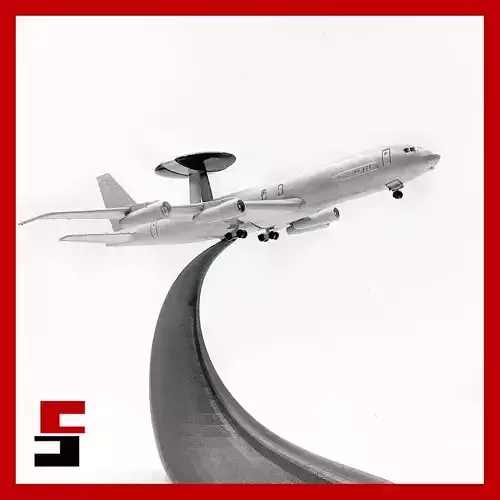1/16
Airplane Boeing E-3 Sentry in Scale 1/50 and 1/25 3D models for 3D printing.
---
Learn how to earn money with 3D printing - www.3dprintingmonetizationacademy.com
Access this and all our other 3D models - www.sliceify.com
We are running a limited-time CRAZY offer. You can get ALL our 300+ premium 3D models for free. Check out before the spots are full - https://www.sliceables.co/crazy-offer-free-trial
If you wish to 3D print and sell this model, you must be a Sliceify member.
---
The Airplane Boeing E-3 Sentry model has been cut into pieces for better 3D printing and post-processing experience.
You will get full and cut versions of the Airplane Boeing E-3 Sentry. The parts are cut to easily fit in Ender 3 printer size (220 x 220 x 250 mm).
Feel free to print The Boeing E-3 Sentry also without the landing gear.
You will also get the stand.
The Airplane Boeing E-3 Sentry has a super assembly.
The Airplane Boeing E-3 Sentry stand is detachable.
The airplane Boeing E-3 Sentry was Made in Blender.
Airplane Boeing E-3 Sentry File type - STL.
Feel free to contact us for any model upgrades, changes, or custom 3D models.
Share your make on social media, tag us and get a free 3D model. @sliceables https://www.instagram.com/sliceables/
The Airplane Boeing E-3 Sentry is an American airborne early warning and control (AEW&C) aircraft developed by Boeing. E-3s are commonly known as AWACS (Airborne Warning and Control System). Derived from the Airplane Boeing 707 airliner, it provides all-weather surveillance, command, control, and communications, and is used by the United States Air Force, NATO, French Air and Space Force, Royal Saudi Air Force and Chilean Air Force. The E-3 is distinguished by the distinctive rotating radar dome (rotodome) above the fuselage. Production ended in 1992 after 68 aircraft had been built. In the mid-1960s, the U.S. Air Force (USAF) was seeking an aircraft to replace its piston-engined Lockheed EC-121 Warning Star, which had been in service for over a decade. After issuing preliminary development contracts to three companies, the USAF picked Boeing to construct two airframes to test Westinghouse Electric and Hughes's competing radars. Both radars used pulse-Doppler technology, with Westinghouse's design emerging as the contract winner. Testing on the first production E-3 began in October 1975. The first Airplane USAF E-3 was delivered in March 1977, and during the next seven years, a total of 34 aircraft were manufactured. E-3s were also purchased by NATO, the United Kingdom, France and Saudi Arabia. In 1991, when the last aircraft had been delivered, E-3s participated in the Persian Gulf War, playing a crucial role of directing coalition aircraft against Iraqi forces. The aircraft's capabilities have been maintained and enhanced through numerous upgrades. In 1996, Westinghouse Electric's Defense & Electronic Systems division was acquired by Northrop Corporation, before being renamed Northrop Grumman Mission Systems, which currently supports the Airplane E-3's radar. In April 2022, the U.S. Air Force announced that the Airplane Boeing 737 AEW&C will be replacing the E-3 beginning in 2027.
REVIEWS & COMMENTS
accuracy, and usability.
















